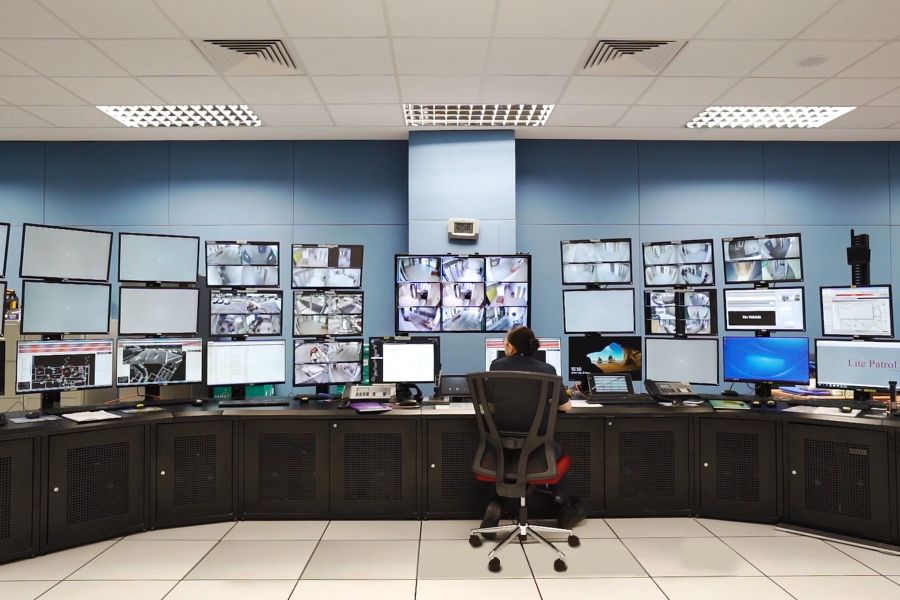Technology Implementation Case
Spain
The use of Virtual Reality (VR) technology is becoming increasingly widespread in psychological therapy and even in the field of forensic psychology. VR is a powerful tool that allows people to experience different environments and situations with ecological validity, resulting in the experience of presence with the illusion of being in a real place (place illusion) and the illusion that the scenario is actually occurring (plausibility illusion) (Slater, 2009).
This article draws on our own experience researching the use of immersive VR in different prisons and rehabilitation centres in Catalonia (Spain) to highlight its potential for managing risk factors in IPV perpetrators and integrating it into traditional treatment programmes. We focus on practical considerations derived from our experience and the opportunities and challenges of introducing this powerful tool into prisons.
Our work suggests that VR is a promising method for reducing specific risk factors for perpetration in offenders and improving emotional recognition as a precursor of empathy (Barnes, 2020; Johnston, 2021; Seinfeld et al., 2018), while also providing a cost-effective way to personalise treatment to participants’ needs through different scenarios.
Overcoming Challenges in Implementing Immersive VR in Prison Settings
Cognitive skills
In our research involving immersive VR in prison settings for IPV offenders (Barnes et al., 2022), we have observed individual differences that must be considered when designing treatment programmes. One area of concern is cognitive skills, which we have evaluated through psychological and empathic tests. Some of our participants (i.e., offenders) have struggled to understand and complete these tests due to language and reading skills, abstraction skills, and concentration skills. To address this, we suggest using alternative assessment techniques such as behavioural, indirect, or implicit measures.
VR can facilitate behavioural assessments that provide a more realistic response from participants and can overcome cognitive skills deficits and social desirability problems. Previous studies in the field of violence and IPV have shown promise for this approach (Johnston, 2021; Rovira et al., 2009; Seinfeld et al., 2018; Slater et al., 2013). It is necessary to adapt assessments to the characteristics of the penitentiary population in both research and applied contexts.
Psychological adjustment
Additionally, it may be necessary to exclude certain offenders from participating in VR intervention sessions if they show signs of maladjustment or have high levels of stress. Being in prison can have negative social, psychological, and biological impacts, including high levels of stress and pre-existing mental disorders that may be exacerbated by the prison context.
Immersive VR has the potential to elicit strong emotional responses and promote psychotherapeutic change, but it is crucial to assess the optimal time for participants to be receptive to the intervention and to be attentive to their situational psychological state.
Rehabilitation clinicians should carefully assess the suitability of participants for group interventions and exclude those with pre-existing psychological disorders that may affect their perceptions of reality. The VR intervention should be integrated into a rehabilitation programme with follow-up to maximise its benefits.
Individual profiles
The possibility of personalising VR experiences for IPV perpetrators was explored, with the addition of fake interoceptive feedback representing fear, but no significant changes in outcomes were found. It was observed that the same virtual intervention does not work in the same way for all individuals, suggesting the need for further research to better understand individual responses to VR interventions based on criminal profiles.
Desirability in prison contexts
In conclusion, virtual reality can be a valuable tool for supporting conventional methods in assessing and treating domestic abuse, being properly integrated into rehabilitation programmes.
However, it is important to note that VR technology alone cannot solve the problem of gender-based violence. It should be seen as a supplementary methodology that complements a comprehensive treatment programme, and requires prior sessions and interviews with professionals.
Continued research is needed to fully understand the benefits and mechanisms of integrating VR into conventional treatment and its impact on each participant’s unique experience.
References
Barnes, N. (2020). El proyecto V-Respect.Me en el Programa de violencia de género en los centros penitenciarios. Centre d’Estudis Jurídics i Formació Especialitzada (CEJFE)
Barnes, N., Sanchez-Vives, M.V., Johnston, T. (2022). On the practical use of immersive virtual reality for rehabilitation of intimate partner violence perpetrators in prison. Frontiers in psychology,597. doi: 10.3389/fpsyg.2022.787483
Davis, M. H. (1980). A multidimensional approach to individual differences in empathy. JSAS Cat. Sel. Doc. Psychol. 10:85
Gonzalez-Liencres, C., Zapata, L., Iruretagoyena, G., Seinfeld. S., Pérez-Mendez, L., Arroyo-Palacios, J., Borland, D., Slater, M., Sanchez-Vives, M.V. (2020). Being the victim of intimate partner violence in virtual reality: first-versus third-person perspective. Frontiers in psychology. 11:820. doi:10.3389/fpsyg.2020.00820Johnston, T. (2021). Assessment, prevention and rehabilitation of intimate partner violence through immersion in virtual reality. Modifying Cognitions, Emotions and Behaviours through Embodied Perspective Taking. Doctoral dissertation. University of Barcelona, Spain.
Mariano, M., Pino, M. C., Peretti, S., Valenti, M., and Mazza, M. (2017). Understanding criminal behavior: empathic impairment in criminal offenders. Soc. Neurosci. 12, 379–385. doi: 10.1080/17470919.2016.1179670
Rovira, A., Swapp, D., Spanlang, B., and Slater, M. (2009). The use of virtual reality in the study of people’s responses to violent incidents. Front. Behav. Neurosci. 3:59. doi: 10.3389/neuro.08.059.2009
Seidel, E. M., Pfabigan, D. M., Keckeis, K., Wucherer, A. M., Jahn, T., Lamm, C., et al. (2013). Empathic competencies in violent offenders. Psychiatry Res. 210, 1168–1175. doi: 10.1016/j.psychres.2013.08.027
Seinfeld, S., Arroyo-Palacios, J., Iruretagoyena, G., Hortensius, R., Zapata, L., Borland, D., et al. (2018). Offenders become the victim in virtual reality: impact of changing perspective in domestic violence. Sci. Rep. 8:2692. doi: 10.1038/s41598-018-19987-7
Seinfeld, S., Zhan, M., Poyo-Solanas, M., Barsuola, G., Vaessen, M., Slater, M., Sanchez-Vives, M.V., de Gelder, B. (2021). Being the victim of virtual abuse changes default mode network responses to emotional expressions. cortex. 135, 268–284. doi: 10.1016/j.cortex.2020.11.018
Slater, M. (2009). Place illusion and plausibility can lead to realistic behaviour in immersive virtual environments. Philosophical Transactions of the Royal Society B: Biological Sciences. 364, 3549–3557. doi: 10.1098/rstb.2009.0138
Slater, M., Rovira, A., Southern, R., Swapp, D., Zhang, J. J., Campbell, C., et al. (2013). Bystander responses to a violent incident in an immersive virtual environment. PLoS One 8:e52766. doi: 10.1371/journal.pone.0052766

Nicolas Barnes is a Forensic Psychologist in the Specialised Intervention Programmess Unit of the General Directorate of Prison Affairs, Department of Justice, Government of Catalonia (Spain). He is responsible for the implementation and supervision of rehabilitation programmes in different areas such as gender violence or violent radicalisation. He is currently pursuing a PhD focused on immersive Virtual Reality in gender violence prison rehabilitation programmes with the Institute of Biomedical Research August Pi i Sunyer (IDIBAPS) and the University of Barcelona. He is a member of the research project VR per GENERE.

Dr Tania Johnston is a clinical psychologist and researcher. After working for 5 years in a mental health centre in France, she completed her PhD in 2021, focusing on the use of VR for the assessment, prevention, and rehabilitation of intimate partner violence. She subsequently completed a post-doctoral fellowship on the same topic in the European project VR per GENERE. Currently, she works as a clinical psychologist at a health tech company using technology to make mental health accessible to everyone.

Dr Ana Gallego is a postdoctoral researcher at the Department of Psychology, University of Jyväskylä, Finland, where she has been an integral staff member since 2017. In 2018, she received a Junior Investigator Poster Award from the Association for Contextual Behavioural Science. Her research focuses on the potential of virtual reality as a tool to enhance psychological interventions, with a particular interest in addressing gender-based violence. She is affiliated with the Faculty of Education and Psychology, University of Jyväskylä (Finland) and JYU.Well, Faculty of Humanities and Social Sciences, University of Jyväskylä (Finland). She is a member of the research project VR per GENERE.

Dr Mavi Sanchez-Vives is an ICREA Research Professor at the Institute for Biomedical Research August Pi i Sunyer in Barcelona, where she leads the Systems Neuroscience group. With a medical degree and a doctorate in neuroscience, she is a researcher and a member of the scientific council of the Human Brain Project. She has been a pioneer in the use of virtual reality in the field of virtual embodiment, investigating applications in psychology and medicine. One of these applications has been on the rehabilitation of violent behaviour, in particular in intimate partner violence in the research project VR per GENERE.


